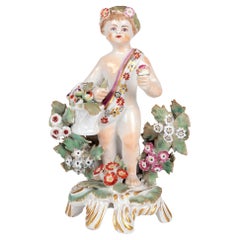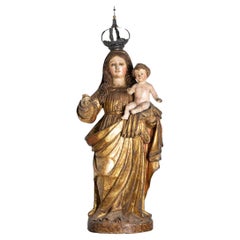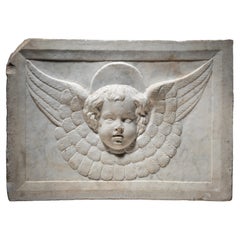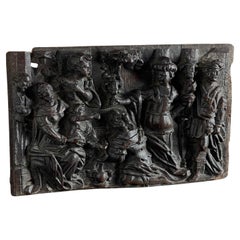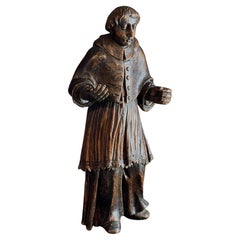18th Century and Earlier Figurative Sculptures
4
1,136
to
172
568
500
1,136
1,136
1,136
191
82
70
15
12
9
5
2
2
1
1
1
1,136
3,836
9,075
2,782
2,340
3,199
1,900
329
159
562
595
255
465
606
600
374
239
Height
to
Width
to
578
254
239
192
96
786
349
185
135
109
49
40
29
13
9
Period: 18th Century and Earlier
Bow English Porcelain Putto Figure With Flowers
Located in Bishop's Stortford, Hertfordshire
A scarce antique English porcelain figure of a Putto holding a basket of flowers by the renowned Staffordshire factory Bow and dating from aro...
Category
English Antique 18th Century and Earlier Figurative Sculptures
Materials
Porcelain
17th Century Baroque Figure Of «Madonna and Jesus», Portugal
Located in Lisbon, PT
A late 17th-century figure in polychromed chestnut wood with excellent carving and gilding, dressed in a flowing veil and cashew hair down the shoulders. The cheekbones and nose are ...
Category
Portuguese Baroque Antique 18th Century and Earlier Figurative Sculptures
Materials
Gold Leaf
Cercle of Jacopo della Pila - Marble relief depicting a winged Cherub
Located in Bruxelles, BE
Cercle of Jacopo della Pila (Lombard, in Naples 1471-1502)
Marble relief depicting a winged Cherub
Naples, second half of15th century
40 x 57 x 12 cm
Exquisitely carved, this relief portrays a winged cherub with cascading hair and delicate features. The cherub's plump, smooth countenance, rounded cheeks, outlined lips, and finely drawn nose emanate a sense of tenderness. The quadrangular module, is adorned with a carved frame. The relief ascends gradually, transitioning from the low relief of the wings to the high relief of the head.
The rectangular frame and the subtly curved form of the artwork suggest that the relief likely adorned the upper part of an arch or a vaulted chapel. The type is that of the perspective room with a coffered ceiling decorated with figures of winged cherubs, which is found in various Neapolitan chapels of the 15th century. Coffered ceilings attest to the recovery of antiquity and the search for luxury in Renaissance architecture, first in Florence, then in Rome and Naples. The majority of the numerous family chapels and tombs built during the late fifteenth century in south of Italy employ the new formal vocabulary of the Florentine Renaissance in a self-confident manner that permitted a broad spectrum of variations.
The escalating admiration for the classical world, coupled with the development of perspective, significantly contributed to the Renaissance endorsement of coffered ceilings. This artistic and constructive device drew inspiration from the intricate marble patterns observed in historical landmarks such as the Arch of Titus, the Temple of Vesta in Tivoli, the Pantheon, and the Basilica of Maxentius. A distilled product of both mathematical and artistic cultures, deeply scrutinizing the ancient world, the coffered ceiling plays a vital role in the perspective construction of space with its regular and directional geometry. The motif of the coffered ceiling decorated with cherubs in relief was introduced in Naples by Francesco Laurana in the plastic decoration of the Arch of Castelnuovo. Laurana's impact on the art scene in the south of Italy was profound. The introduction of the winged cherub into the region's artistic vocabulary bridged the gap between the classical and the contemporary, creating a synthesis that resonated with both aesthetic and spiritual sensibilities. His influence extended beyond the immediate visual appeal, shaping the cultural identity of the Renaissance in southern Italy. Although the plastic decoration of the Arch of Castelnuovo cannot certainly be ascribed to a mature Renaissance style, it was precisely on this occasion that the sculptors who worked there could get to know and export throughout the Italian peninsula that type of "Florentine classicism" which, even in the 15th century Naples, was conditioned by the Burgundian culture imported into the Kingdom by Alfonso of Aragon himself, with artists called from Spain and Northern Europe. The coffered ceiling, with its geometric patterns and Laurana's winged cherubs nestled within, became a symbol of refinement and cultural sophistication. The relief sculptures, carefully integrated into the overall design, transformed the ceiling into a celestial realm, inviting viewers to contemplate the divine while immersed in the grandeur of the Renaissance space.
Similar winged cherubs appears also in the Naples cathedral. Within the renowned Succorpo Chapel, a mesmerizing marble coffered ceiling adorned with cherubs epitomizes the splendor of the Neapolitan Renaissance. The interplay of light and shadow on the textured surface of the marble coffered ceiling introduces an ethereal dimension, providing an immersive visual experience for observers. The geometric precision and the repeated patterns, reminiscent of classical motifs, establish a sense of harmony and balance that has become the hallmark of the Neapolitan interpretation of Florentine Renaissance aesthetics.
Although probably intended to be admired from a distance, this cherub is intricately detailed and exquisitely rendered: the face and hair are elegantly outlined and the feathers are textured through juxtaposed lines. The marble, both figurative and decorative, adheres to the principles of balance and restrained ornamentation typical of the « Florentine Classicism ». Harmonious shapes and gracefully orchestrated curves , rooted in the classical repertoire, converge to evoke a sense of ethereal beauty. The surface displays the masterful use of a chisel to intricately carve the feathers and facial features, creating an almost abstract quality.
This work is a testament to a sculptor of great skill and rich figurative knowledge, seamlessly blending classical firmness in contours with a refined treatment of the marble's surface. The combination of tradition and innovation point to a stylistic idiom from Lombardy, in particular we can find some comparaisons with the works of Jacopo della Pila, sculptor of Lombard origin working in Naples in the second half of the 15th century. He is documented there between 1471 and 1502, and is a protagonist of the Aragon Renaissance in the second half of the Quattrocento, together with the other great Northern sculptor active in the kingdom, Domenico Gagini.
the first commission he received dates back to August 9, 1471, when Jacopo publicly committed to sculpting the funerary monument of Archbishop Nicola Piscicelli to be placed in the Cathedral of Salerno. The last known work is an altar ordered on July 29, 1502, by the noble Jacopo Rocco for the church of San Lorenzo Maggiore in Naples. Between these two chronological extremes (1471-1502), we must place the fervent activity of the artist, who had trained in Rome, perhaps under the guidance of Paolo Romano but also engaged in dialogue with other major artists of the city, especially Isaia da Pisa. He enriched his experience in Naples, initially drawing inspiration from the works of Domenico Gagini and later from the Tuscan masterpieces of Antonio Rossellino and Benedetto da Maiano destined for the church of Santa Maria di Monteoliveto. Jacopo della Pila's artistic personality is thus based on a complex interplay of influences, contributing to the definition of a highly personal style.
Close comparaison can be made between our cherub and the winged angels reliefs...
Category
Italian Renaissance Antique 18th Century and Earlier Figurative Sculptures
Materials
Marble
A Nun, perhaps a theatrical figure. England, probably Plymouth, circa 1750
By Plymouth Porcelain Factory 1
Located in Melbourne, Victoria
An interesting soft-paste porcelain figure of a Dominican Nun, perhaps the theatrical figure Heloise.
Although the Nun appears in various versions in European and English porcelain,...
Category
English Neoclassical Antique 18th Century and Earlier Figurative Sculptures
Materials
Porcelain
A deep and well carved panel English oak 16th century
Located in Bakewell, GB
A deep and well carved panel English oak with many figures in deep relief and a good colour
Circa 1520
33cms wide x 21cms high
Category
English Antique 18th Century and Earlier Figurative Sculptures
Materials
Oak
Excellent walnut carving of a Carlo Boccomico c1600
Located in Bakewell, GB
Excellent walnut carving of a Carlo Boccomico c1600
Visible old dead worm holes, but great condition
72 cms high 30 cms wide
Category
European Antique 18th Century and Earlier Figurative Sculptures
Materials
Walnut
Roman Style Marble Head
Located in Southall, GB
A richly weathered marble Roman style head with skilfully carved features and full lips. The piece would have been part of a larger statue or carving. The marble has a lovely warm pa...
Category
European Classical Roman Antique 18th Century and Earlier Figurative Sculptures
Materials
Marble
Trinity , Polychrome Sculpture , Germany, circa 1550
Located in PARIS, FR
Trinity in carved and polychromed wood, in the round, the back partially hollowed out.
It is represented here as a "Throne of Grace". In this original formula, which probably origina...
Category
Antique 18th Century and Earlier Figurative Sculptures
Materials
Wood
Large 18th Century, Italian Carved Wooden Wing of a Baroque Angel
Located in Buisson, FR
Beautiful large Baroque angel-wing with its original color and gilding. Extremely rare to find in this size.
Very decorative item placed on a wooden base.
Italy, circa 1750. Weathere...
Category
Italian Baroque Antique 18th Century and Earlier Figurative Sculptures
Materials
Wood
Saint John of Calvary, 2nd half of the 15th century
Located in PARIS, FR
Large walnut wood sculpture in the round, depicting Saint John in the position he usually has at the foot of Christ on the Cross.
Beautifully expressive face, framed by expertly curl...
Category
French Renaissance Antique 18th Century and Earlier Figurative Sculptures
Materials
Walnut
JESUS GOOD SHEPHERD Indo-Portuguese Sculpture, 17th Century
Located in Madrid, ES
JESUS GOOD SHEPHERD
Indo-Portuguese Sculpture, 17th Century
in iv... partially painted and gilded.
The baby Jesus, asleep, is depicted sitting cross-legged.
Posterior dobby.
Dim.: ...
Category
Portuguese Renaissance Antique 18th Century and Earlier Figurative Sculptures
Materials
Wood
18th Century Italian Antique Dancing Putto on a base
Located in Encinitas, CA
This piece is an 18th century dancing putto marble statue, now available for purchase.
The sculpture features a small dancing Angel 'Putto" supported on...
Category
Italian Baroque Antique 18th Century and Earlier Figurative Sculptures
Materials
Marble
A 16th century carved marble sculpture of poseidon
Located in London, GB
This fine and imposing sculpture is an excellent example of 16th century Italian craftsmanship. The figure is stood on a raised, shaped rectangular base with a carved "dolphin" at th...
Category
Italian Renaissance Antique 18th Century and Earlier Figurative Sculptures
Materials
Marble
Figurative Knob in Iron 1600 Italian Handle with Bust of Boy
Located in Milan, IT
Iron Bust From 1600 depicting a boy with curly hair, dressed in a tunic that leaves one shoulder uncovered. Made of cast iron, the pommel has a dark patina and is in good condition, ...
Category
Italian Baroque Antique 18th Century and Earlier Figurative Sculptures
Materials
Iron
Figurative Knob in Bronze 1600 Italian Handle with Bust of Boy
Located in Milan, IT
Bronze Bust Of 1600s, cast depicting a young boy with curly hair and a gathered robe over his neck ending in an oval section with beaded border. This antique bronze knob of Italian ...
Category
Italian Baroque Antique 18th Century and Earlier Figurative Sculptures
Materials
Bronze
18th Century Italian Antique Dancing Putto small on a base.
Located in Encinitas, CA
This piece is an 18th century dancing putto marble statue, now available for purchase.
The sculpture features a small dancing Angel 'Putto" supported on...
Category
Italian Baroque Antique 18th Century and Earlier Figurative Sculptures
Materials
Marble
18th Century Polychrome Wood Italian Antique Sculpture Roman Soldier, 1770s
Located in Vicoforte, Piedmont
Great Italian sculpture from the second half of the 18th century. Finished wooden work from the center depicting an almost life-size Roman soldier. Statue complete with lacquered and...
Category
Italian Antique 18th Century and Earlier Figurative Sculptures
Materials
Wood
French White Carrara Marble Sculpture
Located in Dallas, TX
This 1890s French White Carrara Marble Sculpture is a timeless and elegant masterpiece, hand-crafted from the finest marble in France. Its classic design and high-quality material ma...
Category
Antique 18th Century and Earlier Figurative Sculptures
Materials
Carrara Marble
Dutch 17/18th Century Baroque Carved Wooden Coat of Arms
Located in Buisson, FR
Beautiful and very rare hand carved wooden coat of arms with a crowned lion standing on the water reaching to a star.
The Netherlands, circa 1650- 1750.
Weathered, small losses and...
Category
Dutch Baroque Antique 18th Century and Earlier Figurative Sculptures
Materials
Oak
Pair Of Flemish Baroque Carved Oak And Ebony Figural Caryatids
Located in Essex, MA
Likely from a piece of furniture. Featuring a well carved male and female over an ebony panel. Now used as candlesticks.
Category
Dutch Baroque Antique 18th Century and Earlier Figurative Sculptures
Materials
Ebony, Oak
Saint Florian
Located in Saint-Ouen, FR
SAINT FLORIAN
ORIGIN: SOUTH GERMANY, SWABIA
PERIOD: END OF THE 15th CENTURY
Height : 100,5 cm
Width : 34 cm
Depth : 17 cm
Polychromed lime wood
Good state of conservation
Sin...
Category
German Gothic Antique 18th Century and Earlier Figurative Sculptures
Materials
Wood
Virgin and Child in Majesty, also known as "Sedes Sapientae"
Located in Saint-Ouen, FR
VIRGIN AND CHILD IN MAJESTY, ALSO KNOWN AS "SEDES SAPIENTIAE"
ORIGIN : SPAIN, CATALOGNE
PERIOD: EARLY 13th CENTURY
Height : 95 cm
Width : 32 cm
Depth : 28 cm
Softwood
No polychromy
In the middle of the 12th century, the Virgin took her place in churches, seated in Majesty, serving as a throne for her son Jesus. She is then called Sedes Sapientiae, meaning the Throne of Wisdom.
At that time, she is not represented for herself and only exists because she has been designated as Theotokos, the mother of God, at the Council of Ephesus in 431, where the divine nature of Christ was proclaimed from his birth.
The upright and perfectly hieratic bust of this Virgin and Child in Majesty is seated on a throne-bench. She is dressed in a tunic with a rounded neckline and covered with a fine mantle placed on her narrow shoulders. The supple and natural drapery follows the lines of the body.
Large curls frame her face with delicate and regular features, a long straight nose, almond-shaped eyes, and small lips.
She supports the Infant Jesus with her left hand. Like his mother, he is dressed in a long tunic, and his little feet are visible in the folds. He holds a small sphere in his left hand, while with his right hand, he gestures in blessing. The face of Christ bears a strong resemblance to his mother’s one, and he gives a slight smile.
The position of the Child is no longer as hieratic, nor frontal or central as in the early 12th century, but his face still turns towards the faithful.
The 13th century indeed emerges as a period of transition in the artistic domain. The statuary, while retaining certain characteristics still belonging to the habits of the previous century, also develops new formal solutions.
As a result, Mary maintains a hieratic and frontal position, while her son shifts to place himself well to the left on her knee. Similarly, while the Virgin seems perfectly still, Jesus, on the other hand, appears much more animated, especially in the positioning of his hands. His left hand holds the orb, and judging by the raised right arm directed towards the faithful, one can easily imagine that he was making a gesture of blessing.
The influence of the Sedes Sapientiae from previous centuries still seems particularly prevalent in this work.
These few characteristics allow dating this Spanish Virgin...
Category
Spanish Gothic Antique 18th Century and Earlier Figurative Sculptures
Materials
Softwood
Basalt Portrait Medallion, Edward Bourne, Wedgwood, circa 1780
By Wedgwood
Located in Melbourne, Victoria
Portrait Medallion of Edward Bourne, bricklayer at the Wedgwood factory. A bricklayer was kept on staff in order to maintain the kilns.
This was modelled by Hackwood as an excercise...
Category
English Neoclassical Antique 18th Century and Earlier Figurative Sculptures
Materials
Stoneware
Italian Baroque Madonna and Child Sculpture, 18th Century
Located in Lisbon, PT
A 18th Century superb italian sculpture of a draped Madonna with a veil, base with richly carved relief with cherubs and a baby Jesus on her lap in carved polychrome and gilded wood....
Category
Italian Baroque Antique 18th Century and Earlier Figurative Sculptures
Materials
Gold Leaf
Saint Woman in polychrome carved wood
Located in Saint-Ouen, FR
SAINT WOMAN IN POLYCHROME CARVED WOOD
ORIGIN : ITALY
PERIOD : late 13th century
Height : 103 cm
Length : 28 cm
Width : 16 cm
Remains of polychromy
...
Category
Italian Gothic Antique 18th Century and Earlier Figurative Sculptures
Materials
Softwood
Madonna of Milk, polychrome stucco relief, Florence, 16th century
Located in Brescia, IT
Our Lady of Milk
polychrome stucco relief
scope of Benedetto da Maiano
Florence, 16th century
cm 66 x 18 x 43
From the 15th century onward, the pleasure of modeling terracotta...
Category
Italian Renaissance Antique 18th Century and Earlier Figurative Sculptures
Materials
Gesso, Straw
Antique 18th c. Italian Armor Mannequin c.1700s
Located in San Francisco, CA
ABOUT
An original 18th century Italian armorer's model with glass eyes and articulating arms. Used to fit different types of battle armor. Shows signs of light wear and paint loss...
Category
Italian Antique 18th Century and Earlier Figurative Sculptures
Materials
Wood, Paint
Italian 17th Century Baroque Period Giltwood And Patinated Wood Putti Statue
Located in West Palm Beach, FL
An elegant and extremely decorative Italian 17th century Baroque period Giltwood and patinated wood Putti statue. The statue is raised by a Giltwood plinth with a Coeur-de-Rai carved...
Category
Italian Baroque Antique 18th Century and Earlier Figurative Sculptures
Materials
Wood, Giltwood
A PAIR OF FINELY CARVED BOX WOOD Figures Of Beggars
Located in Lincolnshire, GB
A pair of 18th century German figures of one legged beggars after the engravings of Rembrandt in box wood.
Circa 1780
Category
German Antique 18th Century and Earlier Figurative Sculptures
Materials
Boxwood
After Francisco Ruiz Gijon, St. Francis, Spanish Baroque Wood Sculpture, 17th C.
Located in New York, NY
Baroque
After Francisco Ruiz Gijon
Saint Francis of Assisi
Polychrome and Parcel Gilt Carved Wood, Insert Glass Eyes
Spain, Late 17th Century
Francisc...
Category
Spanish Baroque Antique 18th Century and Earlier Figurative Sculptures
Materials
Glass, Wood
Pair of French 18th Century Bronze Statues of Satyrs, Signed Clodion
Located in New Orleans, LA
This magnificent matched pair of bronze figures was created by the well known bronzier Clodion in the late 18th century. The pair is a fantastic reflection of Clodion’s skill and cel...
Category
French Antique 18th Century and Earlier Figurative Sculptures
Materials
Gold Plate, Bronze
Early Italian Carved Figure Of A Seated King
Located in Essex, MA
Figure seated on rock work wearing a crown.
Category
Italian Baroque Antique 18th Century and Earlier Figurative Sculptures
Materials
Walnut
Seated Virgin with Child (Sedes Sapientiae) from the 12th Century in Spain
Located in Madrid, ES
Technique: Tempera and oil on wood
Dimensions: 25 x 11 x 8 cm
Description:
This exceptional work from the 12th century represents the Seated Virgin with Child (Sedes Sapientiae), standing out as an artistic treasure from medieval Spain. The portrayal of the Virgin enthroned with the Child on her lap is emblematic of Romanesque art, and this particular piece is a valuable and authentic example of that era.
The current polychromy belongs to the Gothic period and overlays the original Romanesque layer. It is crucial to highlight that the current state of the artwork is the original, without any cleaning interventions, imparting a unique authenticity.
The work exhibits architectural characteristics typical of Romanesque art, evident in the sides of the throne. The rigidity and symmetry characteristic of this style are reflected in the firm presentation of the Baby Jesus, noticeable in his gesture while holding his son. The Virgin wears a crown, symbolizing her royal character as the Queen of Heaven and Creation. Both figures retain traces of polychromy on the face and attire, adding layers of history and authenticity.
While similar Romanesque Virgin...
Category
Antique 18th Century and Earlier Figurative Sculptures
Materials
Fruitwood
Late 18th Century dancing couple figurine by Volksted
Located in Lisbon, PT
A charming translucent soft-paste german porcelain figurine of a dancing couple of the Volkstedt, Muller & Co, Dresden manufacturing of the late 18th century, mark on the base
Category
German Baroque Antique 18th Century and Earlier Figurative Sculptures
Materials
Porcelain
18th Century Italian Sunray Mounted on a Yellow Hematoid Quartz Heart
By Interi
Located in Dublin, Dalkey
Sculptural Sacred Heart - 18th century Italian sunray mounted on a yellow hematoid heart and adorned with yellow crystal quartz points. The piece is inspired by "The Sacred Heart" in...
Category
Italian Rococo Antique 18th Century and Earlier Figurative Sculptures
Materials
Quartz, Rock Crystal, Gold Leaf
Red Hematoid Quartz Heart with an 18th Century Italian Cross on a Baroque Pearls
By Interi
Located in Dublin, Dalkey
Sculptural 'Sacred Heart' - 18th century Italian cross mounted on a polished red hematoid quartz heart and adorned with natural-forming baroque pearls and a cross-shaped baroque pear...
Category
Italian Rococo Antique 18th Century and Earlier Figurative Sculptures
Materials
Quartz, Gold Leaf
Italian Painted and Lacquered Wooden Sculpture of a Kneeling Figure, Circa 1650
Located in CH
Italian Baroque painted and lacquered wooden sculpture of a kneeling figure. Circa 1650.
Category
Italian Baroque Antique 18th Century and Earlier Figurative Sculptures
Materials
Wood
Antique 18th Century Bow English Porcelain Figure of a Flute Player
Located in Philadelphia, PA
An antique English porcelain figurine.
By Bow.
In the form of a boy clothed in 18th century garb and holding a flute.
We've noted losse...
Category
English Georgian Antique 18th Century and Earlier Figurative Sculptures
Materials
Porcelain
Roman Column, 1st Century A.D, Spain
Located in Girona, Spain
Roman column.
Made with marble.
1st Century A.D, Spain
Very decorative.
Good Condition.
With certificate of authenticity.
Provenance: Caldes de Mont Bui
N...
Category
Spanish Classical Roman Antique 18th Century and Earlier Figurative Sculptures
Materials
Marble
Guanyin Buddha
Located in Munich, DE
Rare vintage Buddha, the Bodhisattva of compassion and mercy.
Category
Antique 18th Century and Earlier Figurative Sculptures
Materials
Stone
Two Figurine of Seated Boys, Circa 1725, Qing Dynasty, Yongzheng Reign
Located in seoul, KR
Wearing a blue-glazed short child's apron knotted around the waist, his hair drawn into one or two topknots
Period : Qing Dynasty, Yongzheng Period
Production Date : C 1725
Made in ...
Category
Chinese Chinoiserie Antique 18th Century and Earlier Figurative Sculptures
Materials
Ceramic
Immaculate Conception Baroque Sculpture, 18th Century - Religious Art
Located in Lisbon, PT
A rare and unique baroque Spanish sculpture of the Immaculate Conception in polychromed chestnut carving wood and a silver crown, with a original wooden podium...
Category
Spanish Baroque Antique 18th Century and Earlier Figurative Sculptures
Materials
Wood
17th Century Flemisch Madonna & Child Bone Carving
Located in Nottingham, GB
In good condition
From a private collection
Free international shipping
17th Century Flemisch Madonna & Child Bone Carving
Category
Antique 18th Century and Earlier Figurative Sculptures
Materials
Antler
18th Century Wooden Sculpture of the Virgin Mary
Located in Madrid, ES
This exceptional sculpture, finely carved from solid wood and dating back to the 18th century, pays tribute to the devotion and artistic skill of its era. Depicting the Virgin Mary, ...
Category
Antique 18th Century and Earlier Figurative Sculptures
Materials
Fruitwood
Tang Dynasty Museum Quality TL Tested Terracotta Fat Lady Figure
Located in Dallas, TX
Tang Dynasty painted terracotta fat lady tomb figure
China. Tang Dynasty Circa 618-907
Modelled in the form of a classically dressed fat lady, this terraco...
Category
Chinese Tang Antique 18th Century and Earlier Figurative Sculptures
Materials
Terracotta
Wooden Madonna with Child Baroque Art Italy 17th Century with Export Certificate
Located in Madrid, ES
A Wooden Madonna with child Baroque art, Southern Italy, 17th century.
Measure: H: 71cm
Good condition for the time.
With Export Certificate to USA.
Category
Italian Baroque Antique 18th Century and Earlier Figurative Sculptures
Materials
Wood
J A Houdon france bronze 1790 "Diane" by Barbedienne founder.
Located in Rio De Janeiro, RJ
Incredible J A Houdon bronze 1790 representing "Diane" with bow and arrow by Barbedienne founder.
Category
French Empire Antique 18th Century and Earlier Figurative Sculptures
Materials
Bronze
Sculptural 18th Century Italian Mecca Arrow on a Polished Calcite Base
By Interi
Located in Dublin, Dalkey
18th-century distressed Italian mecca arrow with a baroque pearl on a polished calcite base.
The arrow was once part of a decorative motif in an artistic depiction in historic Itali...
Category
Italian Rococo Antique 18th Century and Earlier Figurative Sculptures
Materials
Rock Crystal, Gold Leaf
French 17th Century Baroque Carved Wood Figural Sculptures, a Pair
Located in Los Angeles, CA
Beautiful pair of French 17th Century Baroque carved wood figural sculptures. Amazing carving details with fabrics and faces being perfectly detailed. Each is made of solid wood in a...
Category
French Baroque Antique 18th Century and Earlier Figurative Sculptures
Materials
Wood
Sculptural 18th Century Italian Mecca Gilt Arrow on a Polished Calcite Base
By Interi
Located in Dublin, Dalkey
18th-century distressed Italian mecca gilt arrow with a baroque pearl on a polished calcite base.
The arrow was once part of a decorative motif in an artistic depiction in historic ...
Category
Italian Rococo Antique 18th Century and Earlier Figurative Sculptures
Materials
Rock Crystal, Gold Leaf
Pre-Columbian Ceramic Head Fragment
Located in Chicago, IL
This intriguing head fragment was once attached to a pre-Columbian bust or full effigy figurine. Earthenware figurines like this were made in great abundance throughout Mesoamerican history, serving a wide variety of purposes and functions from religious rituals to burial offerings.
Figurines like this commemorated important people and events across Mesoamerica, portraying individuals of different rank and status such as soldiers, merchants, bureaucrats, and occasionally divinities. This figure is adorned with an elaborate headdress, or coiffure, and ear spools...
Category
Central American Pre-Columbian Antique 18th Century and Earlier Figurative Sculptures
Materials
Ceramic
Japanese antique wooden small Buddha statue / Edo period / 17th to 18th century
Located in Sammu-shi, Chiba
This is a wooden Buddha statue made during the Edo period in Japan.
The material is cypress wood.
After that, it is painted white, then covered with black lacquer, and then painted o...
Category
Japanese Edo Antique 18th Century and Earlier Figurative Sculptures
Materials
Cypress
Misericord. Carved wood. 16th century.
Located in Madrid, ES
Choir Mercy. Carved wood. Century XVI.
Carved wooden Misericordia that surely belonged to a choir stall (see the upper flat part, which acts as a seat), decorated with a figurative ...
Category
European Renaissance Antique 18th Century and Earlier Figurative Sculptures
Materials
Other
Baroque Brazilian Sculpture by Antonio Francisco Lisboa “Aleijadinho” 18th centu
Located in London, GB
A very rare Baroque wooden carved sculpture by the Brazilian sculptor Antônio Francisco Lisboa, known as “Aleijadinho” (1738-1814)
Original polychrome detailing
Circa 1790
Height 1...
Category
Brazilian Baroque Antique 18th Century and Earlier Figurative Sculptures
Materials
Wood
A 17th Century Mounted French Limestone Carving of a Winged Angel
Located in Dallas, TX
Originally part of a larger architectural from a French building in the 1600s, this hand-carved limestone fragment of a winged angel has been mounted more recently to a painted black...
Category
French Baroque Antique 18th Century and Earlier Figurative Sculptures
Materials
Limestone, Stone, Metal
Eastern Indian Brass Figure of Venugopala, 17th-18th Century
Located in Kensington, MD
Standing with his legs crossed, his right foot resting on a naga hood, a gada supporting his right knee, two Nandi bulls on the square base, the god's two l...
Category
Indian Tribal Antique 18th Century and Earlier Figurative Sculptures
Materials
Bronze
Peruvian Bolivian Colonial Painting Virgin Oil on Canvas 19th C
Located in London, GB
A fine 19th painting of the Virgin del Castillo's
South American Peru or Bolivia school 19th century
Signed Balbino Edo, Pinto 1859
Oil on canvas, 72 by 98cms. 36 x 27 inches
Con...
Category
Peruvian Antique 18th Century and Earlier Figurative Sculptures
Materials
Paint
Zwei geflügelte Engelsköpfe, Holz geschnitzt, Flandern, 18. Jh.
Located in Mönchengladbach, NW
Zwei geflügelte Engelsköpfe, Holz geschnitzt und einfarbig bemalt, Flandern, 18. Jh., alte Restaurierung
H 25 / 27 cm, B 30 / 34 cm, T 10 cm
Category
Belgian Antique 18th Century and Earlier Figurative Sculptures
Materials
Wood
Recently Viewed
View AllMore Ways To Browse
Late Renaissance Florence
Antique Trident
Roman Sword
Bronze Male Head
Bronze Age Pottery
1960 Mexican Carved Furniture
Bronze By Carrier Belleuse
Antique Egyptian Statues
Grand Tour Model Antiques
Classic Roman Sculptures
Cupid Marble Sculpture
Red Marble Plinth
Antique Bow Arrow
Cherub Statues
Egyptian Statue Antique
Harlequin Sculpture
Goddess Art Nouveau
Art Deco Alabaster Sculptures
